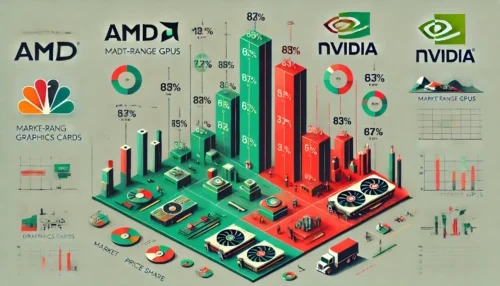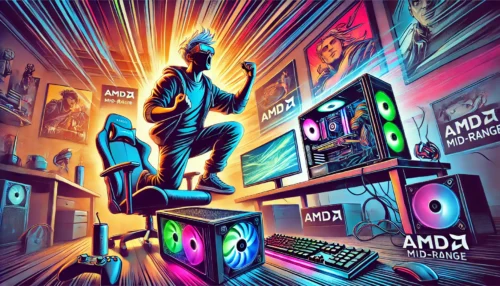In the realm of graphics processing units (GPUs), competition is fierce, and the race to dominate the market is more intense than ever. While NVIDIA has long been the reigning champion, particularly with its high-end offerings like the RTX 4090, AMD is pivoting to a new strategy that could significantly alter the playing field. Rather than chasing the high-end segment, AMD is refocusing its efforts on mid-range GPUs, a category that caters to a much broader audience. This decision could spell a market shift and make AMD a formidable competitor in the realm of mid-tier graphics cards.
![]()
AMD’s Strategic Shift: A Focus on the Mid-Range GPUs Market
When it comes to GPUs, many users have often found themselves weighing performance against cost. AMD’s latest move signals a clear understanding of this dynamic. Instead of attempting to dethrone NVIDIA’s top-tier GPUs, such as the RTX 4090, AMD is choosing to prioritize mid-range GPUs, which offer a compelling mix of performance and affordability.
This decision isn’t entirely new for AMD; they’ve played this card before, with considerable success. Take the RX 400 series, for example—launched a few years ago, it was an immediate hit among gamers and tech enthusiasts. The RX 480, in particular, became a go-to choice for those looking for powerful performance without breaking the bank. With its focus on mid-range GPUs, AMD is looking to replicate that success by tapping into a segment of the market where they can truly shine.
Why Mid-Range GPUs Matter More Than Ever
The Shift in Consumer Demand
The reality is that most gamers and PC users aren’t looking for the most expensive, high-end GPUs. According to a 2023 report by JPR Research, nearly 65% of all GPU sales are within the mid-range segment—defined as those priced between $250 to $600. These consumers seek a balance: good graphics performance at a reasonable price point. AMD’s pivot toward this market isn’t just a strategic decision; it’s a reflection of where the largest customer base is.

The Legacy of Success: AMD’s Past Strategies
Let’s step back a few years to 2016, when AMD introduced the RX 480. The timing was perfect; the market was yearning for an affordable yet powerful graphics card, and AMD delivered. With a price point that hovered around $199 at launch, the RX 480 quickly became a fan favorite, winning over gamers and tech enthusiasts alike. It wasn’t the most powerful GPU available, but it hit the sweet spot of price-to-performance, effectively disrupting the market and forcing NVIDIA to respond with its own mid-range alternatives.
Mid-Range Mastery: A Proven Path
AMD’s decision to refocus on the mid-range market isn’t just a reactionary measure—it’s a calculated move based on historical success. By choosing to compete where the demand is highest, AMD has the potential to capture a significant portion of the market. The RX 400 series taught AMD that dominance doesn’t always come from having the “best” product in terms of raw power; sometimes, it’s about having the right product for the right price.
Why This Matters for Gamers and PC Builders
Affordable Graphics Cards for the Masses
For millions of gamers worldwide, budget constraints are a significant factor when building or upgrading a PC. High-end GPUs like NVIDIA’s RTX 4090 are financially out of reach for many, creating an opportunity for AMD. By focusing on mid-range GPUs, AMD is positioning itself as the go-to brand for affordable graphics cards. This could mean more accessible gaming experiences without compromising too much on performance—a win-win situation for consumers.
The AMD Advantage: Value and Accessibility
AMD’s strategy is simple yet effective: make gaming accessible to a larger audience. A representative from AMD recently commented, “We don’t want to be the company that only people who can afford Porsches and Ferraris buy from. We want to build gaming systems for millions of users.” This vision aligns perfectly with the needs of the market, where affordability is often a deciding factor.
The Market Impact of Focusing on the Mid-Range
By zeroing in on mid-range GPUs, AMD is poised to offer competitive alternatives that could disrupt NVIDIA’s hold on the market. While NVIDIA continues to focus on pushing the boundaries of what’s possible with ultra-high-end GPUs, AMD’s strategy recognizes that most of the battle takes place in the mid-tier space. It’s here where AMD can offer the best value for money, with GPUs like the RX 7600 and the upcoming RX 7800 series, potentially sweeping the market.
Data-Driven Insights: Why AMD’s Strategy Makes Sense
According to a recent study by DataQuest, the mid-range GPU market is expected to grow by 12% annually over the next five years. This growth is driven primarily by the increasing popularity of PC gaming in emerging markets and the rising demand for affordable, high-performance gaming hardware. By realigning its focus, AMD is setting itself up to capture a significant share of this expanding market.
Practical Scenarios and Future Projections
Consider a hypothetical scenario: If AMD can secure even 20% more of the mid-range market over the next two years, it could translate to millions in additional revenue and potentially pressure NVIDIA to lower its prices or rethink its strategy. A move like this could lead to a more competitive market, benefitting consumers by providing more choices at varying price points.
Contrasting Viewpoints: Is This the Right Move?
Of course, some argue that by not competing directly with NVIDIA’s top-tier GPUs, AMD may lose out on the prestige that comes with being seen as a leader in technological innovation. However, it’s essential to remember that AMD’s primary goal is not just to compete but to succeed in the market segments where they can deliver the most value. By strategically choosing to focus on mid-range GPUs, AMD is positioning itself to win over a larger audience and generate sustainable growth.
Expert Opinions: A Calculated Risk or a Missed Opportunity?
In an interview with Tom’s Hardware, graphics industry analyst Mike Chen remarked, “AMD’s decision to target the mid-range GPU market is smart. They’re playing to their strengths and focusing on where they have a clear competitive advantage. Sure, they might not have the flashiest card on the market, but for most gamers, that doesn’t matter as much as getting a solid performance at a reasonable price.”
The Future of GPU Market Dynamics
With AMD’s renewed focus on mid-range GPUs, the market dynamics could shift considerably over the next few years. If AMD successfully captures a more significant share of the mid-tier market, we may see increased competition and innovation from both AMD and NVIDIA. This competition could ultimately benefit consumers, providing better value, more options, and potentially driving down prices across the board.

Conclusion
AMD’s decision to focus on mid-range GPUs represents a strategic pivot that could have far-reaching implications for the GPU market. By targeting a larger audience and prioritizing affordability without compromising too much on performance, AMD is poised to become a more significant player in the graphics card market. For gamers and PC builders, this is an exciting development that could lead to more choices, better value, and a more dynamic market environment.
When considering a new GPU, many gamers and PC builders ask, “Are AMD Graphics Cards Good?” Understanding the pros and cons of AMD graphics cards can provide valuable insights into how they stack up against the competition. For a deeper exploration of AMD’s strengths and weaknesses, you can check out this comprehensive guide that breaks down their performance, value, and overall market position.
Whether AMD’s strategy will pay off in the long term remains to be seen, but one thing is clear: they’re not backing down from the fight. Instead, they’re choosing a path that aligns with their strengths and the needs of the broader market. As the GPU wars continue to unfold, AMD’s focus on mid-range offerings could very well be the key to disrupting NVIDIA’s dominance and reshaping the future of gaming.
FAQs
What is the flaw with AMD GPU?
AMD GPUs have faced criticism mainly for their driver issues and higher power consumption compared to NVIDIA counterparts. Some users report occasional instability or performance inconsistencies in certain games or software due to driver-related problems. Additionally, while AMD has improved its power efficiency in recent years, some of its GPUs still consume more power and produce more heat than NVIDIA cards, which may require better cooling solutions and could result in higher electricity costs.
What is the advantage of AMD GPU over Nvidia?
AMD GPUs are often praised for their better price-to-performance ratio, making them a popular choice among gamers looking for affordable graphics cards that deliver solid performance. AMD also tends to offer more VRAM for the price, which can be beneficial in handling high-resolution textures and future-proofing your system for upcoming games. Additionally, AMD’s open-source technology, like FreeSync, allows for broader compatibility with monitors, providing smoother gaming experiences without screen tearing or stuttering.
What is AMD’s GPU market share?
As of 2024, AMD holds around 19% of the discrete GPU market share, while NVIDIA dominates the market with about 81%. Although NVIDIA leads in the high-end segment, AMD is gradually gaining traction in the mid-range GPU market due to its focus on affordability and competitive performance, attracting a broader base of gamers and PC builders.
Why does Nvidia dominate the market?
NVIDIA dominates the GPU market primarily due to its cutting-edge technology, such as Ray Tracing and DLSS (Deep Learning Super Sampling), which offer enhanced graphics quality and performance in gaming. NVIDIA also maintains a strong ecosystem with optimized drivers, frequent updates, and extensive partnerships with game developers, ensuring that its GPUs perform exceptionally well across a wide range of applications. Furthermore, its reputation for high-end performance GPUs solidifies its position as the market leader.
